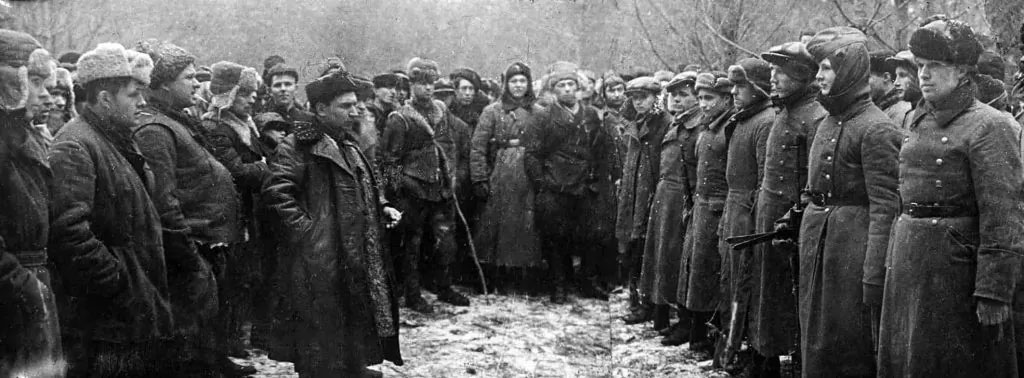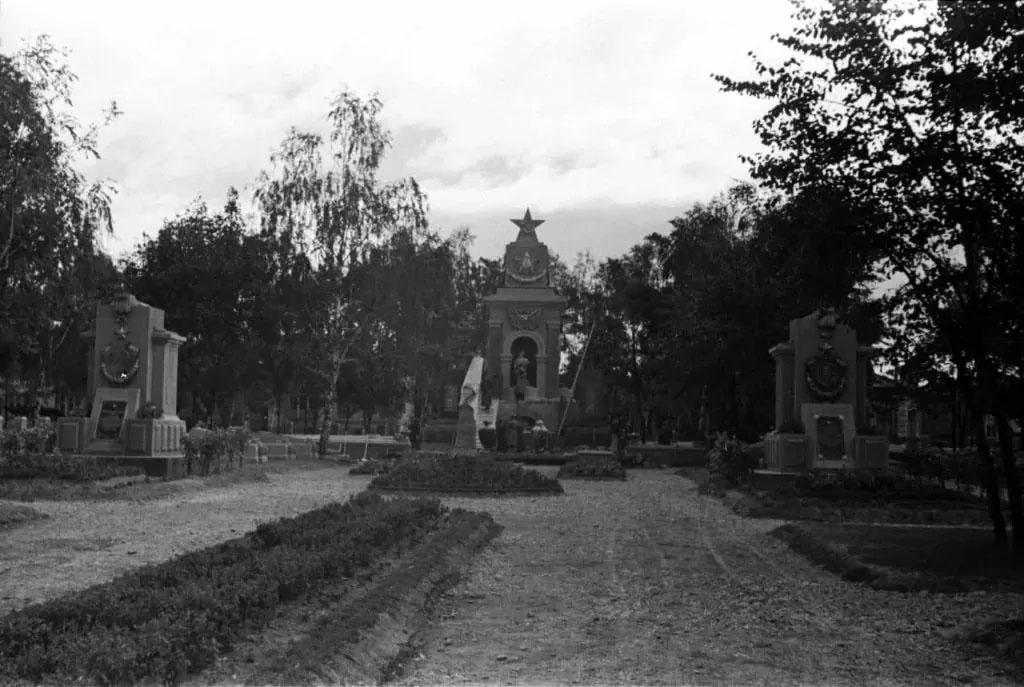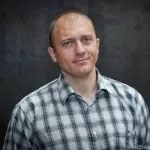Oleksandr Melnyk: "Whereas the Soviet metanarrative talked about the contribution of various peoples to the victory over Nazism, the contemporary Russian state is trying to privatize it."

The conversation with the Ukrainian-Canadian historian Oleksandr Melnyk is about his recently published monograph, World War II As an Identity Project. He finished inputting corrections to it in the Kherson oblast, occupied by Russian troops at the time. After arriving in Ukraine, he saw first-hand the workings of some of the processes he has researched for the past twenty years. The conversation touches on how the experience of the current [Russo-Ukrainian] war had an impact on his views, how the USSR and Putin's Russia are converting the legacy of the Second World War into "symbolic currency," and how we should reinterpret this difficult legacy of the past given the propaganda policies of the aggressor country.
"Overcoming the past" means, first and foremost, acceptance of the past and the maximum possible emancipation of the historical discourse from the diktat of narrow concepts of identity that frequently lead to a simplistic and distorted perception of history."
The column "Overcoming the Past," featured on the website of Ukraina Moderna, examines the totalitarian violence of the Nazi and Soviet regimes during the Second World War, focusing on the history of the Holocaust. My first question has to do with the very title of this column. What does "overcoming the past" mean to you in today's realities?
I will begin with the statement that historians, of course, are not isolated from the broader context. One example that may be cited is the origin of the phrase "overcoming the past." It is rooted in German discussions in the 1960s–1980s about National Socialism, at the heart of which lay the question of the Germans' political and moral accountability for the crimes of the Nazi regime. I got the impression that at a certain stage, there were expectations in the Western academic milieu that Ukrainian society, too, must follow the same path of overcoming its past via a critical assessment of occupation and collaboration during the killings of Jews. Tangential to this discourse were discussions about the ideology and practices of Ukrainian nationalism in the 1930s and 1940s, particularly in the context of the Ukrainian-Polish conflict. However, under the influence of Eastern European discourses, this concept increasingly came to encompass also the crimes of communist regimes. Starting in the late 1980s, questions concerning the Holodomor of 1932–33, the mass repressions, the crushing of national movements, and the struggle against dissidents in the late Soviet period became especially relevant to Ukraine. In the context of the Western academic community, the publication of Timothy Snyder's Bloodlands in 2011 was a turning point.

For me as a researcher, "overcoming the past" means, first and foremost, acceptance of the past and the maximum possible emancipation of the historical discourse from the diktat of narrow concepts of identity that frequently lead to a simplistic and distorted perception of history. In this sense, "overcoming the past" is a shift from the simpler to the more complex. I am talking about the intellectual and emotional maturation of a researcher or the average reader/listener. This process is never-ending, just as reinterpreting the past under the influence of contemporary geopolitical, domestic-political, and sociocultural factors never ends. There is always a certain inertia of ideas and views concerning historical events. Society is a complex system.
People have diverse family memories and experiences of communicating with various milieus, different levels of information awareness, and the capacity to absorb information, especially in current technological conditions. There are multiple levels of historical thinking. On the one hand, there is the level of elite researchers — one of rationality, critical thinking, complexity, and multidimensionality. There is also the mass audience level. This is the political level, one of collective emotions and identity discourses. Here, people often have neither the time nor the resources to fully study more complex questions. They need professional interpreters of complex material.
These two different knowledge regimes are not hermetically isolated from each other, and both are significant. There should be a certain level of mutual tolerance. Professional historians should take as a given the fact that most people work with the past on the level of limited conceptualization, and nothing can be done about this, especially in the age of the Internet and social media. On the other hand, preserving institutions of elite scholarship is important because they are the engine of new knowledge production. I believe that the reader must be encouraged to strive towards greater complexity.
At present, however, the situation is such that professional historians are urged to simplify the material and make it more accessible. Among other things, such calls for the "democratization" of knowledge will have negative consequences for institutions of historical scholarship. At times, readers do not understand certain things because they have not achieved a certain level of knowledge (not because the text is insufficiently accessible and clear). Another consequence of such "democratization" will be that scholarly institutions will become hostages of current identity politics. In other words, this or that society will be examined not based on the logic of past events but mostly through the optics of contemporary political discussions, particularly those taking place in more influential and more prestigious countries that have more resources at their disposal.
"The full-scale invasion allowed me to see certain processes that I had been studying for the past twenty years."
Ibidem recently published your book World War II As an Identity Project: Historicism, Legitimacy Contests and the (Re-)Construction of Political Communities in Ukraine, 1939–1946. Could you tell us when and under what circumstances you thought of writing this book?

This book developed from my doctoral dissertation that I defended at the University of Toronto in 2016. It was preceded by my Master's dissertation at the University of Alberta. My interest in history in general and the history of the Second World War, in particular, stems from my identity at the time and the specific experience of growing up in the USSR in the 1980s. I am talking about books and films about the "Great Patriotic War," festive parades on 9 May in the center of the town and the military cemetery, and subsequent informal, private socialization. My grandfather and grandmother also talked to me often about the war.
One particular episode is engraved on my mind. One day, my grandfather took me to the local monument to town residents and pointed to the surnames of his cousins and uncles. I also remember the stern look of my schoolmate's grandfather, who went through the war, received many awards, and frequently came to the school to recount his experiences. We, pupils, took part in cleaning up the military cemetery several times and attended commemorative rituals. Our school was named in honor of Petro Korbut, Hero of the Soviet Union, the commander of a tank brigade who was killed in the area during the battle on the Nikopol bridgehead. Thus, the memory of the Second World War was an important part of the cultural landscape in which I grew up. In fact, the title of my book (World War II As an Identity Project) can serve as a reference to my personal experience.
What impact did the military and political events after 24 February 2022 make on completing your book? I believe you were putting the finishing touches while under Russian occupation. How did this affect your rethinking of the material?
In the recent past, I lived in my village on the left bank of the Dnipro in Kherson oblast. At a certain stage, after nearly twenty years of living abroad, I wanted to spend time at home. But the [COVID] pandemic broke out. During this time, I wrote two chapters. When the war began, the book was already at the editing stage. The war and the occupation did not, in fact, have a strong impact on the text. More important in this context was the start of the war in the Donbas in 2014–2015. That was when I clearly understood the logic of building and breaking political communities. The full-scale invasion simply allowed me to see certain processes that I had been studying for the last twenty years. Already at that time, I began to think about a new book, although it was not certain that I would complete this unplanned fieldwork. But I did.
At the start of the twenty-first century, Russia once again began to view the Second World War as the defining aspect of its contemporary imperial identity. How should we reinterpret the war, given its instrumentalization by the aggressor country? Should we be resorting to our own politics of "counterpropaganda," or do we need to apply more scholarly approaches?
Russia indeed continues to cultivate and instrumentalize the memory of the Second World War. But we must understand that the current Russian discourse differs substantially from the Soviet one. The latter was not static, either. In my book, I write about the transformation of Soviet historical culture during the Khrushchev Thaw. Commemorations began during the war as ideological campaigns aimed at mobilizing the population to fight the invaders. During this period, attention was focused on the Stalin cult, military leaders, and heroes. In fact, all of Stalinist historical culture may be defined as a culture of heroic masculinity. This is a culture of a militarized society that came out of the First World War, two revolutions, and numerous armed conflicts on the territory of the former Russian Empire in 1917–1921. The basic attributes of Stalinist historical culture were militarism, power hierarchies, and coercion.
During the Thaw, its focus shifted somewhat under the influence of ordinary combatants. Empathy toward rank-and-file soldiers and war victims, especially in occupied territory, and toward victims of political repressions, gained more importance. Pacifism, rather than militarism, became the defining element of Soviet culture, which was a key factor in the peaceful collapse of the USSR. We can see how the pendulum has swung back to the values of a militarized society in Putin's time, which happened gradually during peacetime. The pacifist slogans of the late Soviet period ("No one is forgotten; nothing has been forgotten") have changed into the revanchist "We can repeat it."

On the other hand, whereas the Soviet metanarrative talked about the contribution of various peoples to the victory over Nazism, the contemporary Russian state is trying to privatize it. At the same time, this is taking place first and foremost through the symbolic appropriation of the war's combatants, rather than denying the multinational character of the Red Army. It is as if all Soviet soldiers were Russians by default, and their descendants can claim this symbolic legacy only within the framework of such discourse.
In addition, a targeted policy to delegitimize the Ukrainian state and identity is being implemented. Among other things, this is being done by focusing excessive attention on questions of collaborationism and the crimes of Ukrainian nationalists, coupled with the absence of proper contextualization and suppression of the history of political and ethnic conflicts and the Stalinist regime's crimes. During the war, the Soviet Union preferred to steer clear of such issues. The crimes of the OUN and the UPA were primarily discussed at the local level. In 1946, when the question arose about holding a public trial of a number of OUN leaders, the relevant decision was never made.
Furthermore, little was said about the collaborationism of broader population segments. Instead, the Soviet state focused attention on Nazi crimes. This discourse was important both for the political mobilization of the wartime society and the relegitimization of the Soviet state in the territories that were occupied by the Nazis and their allies.
Ukraine will have to construct its own metanarrative and clarify its attitude toward the Soviet power and the organized nationalist movement. Clearly, this will be happening on various levels. It is much easier to do this on the level of scholarly discourse. It is a much more complex task in the sphere of public commemorations because here, Ukrainian remembrance policy is in conflict with not only the RF's identity discourses but also those of Poland, Israel, and, to a certain extent, Germany and the Anglo-Saxon world. From the standpoint of external metanarratives, the uncritical glorification of the OUN and the UPA is a problem both in terms of ideology and the OUN's and UPA's wartime practices. Ukraine cannot afford to delegitimize these organizations entirely because, in the extraordinarily complex geopolitical context of the Second World War, they expressed the national sentiments of the residents of Ukraine's western oblasts in the most concentrated fashion. The struggle for statehood in 1917–1921 failed. The Entente states did not support the Ukrainian national movement, and Poland and the USSR openly opposed it.
At the same time, in the case of the USSR, the activity of political parties was impossible, while Poland, at a certain stage, set its course for restricting the rights of the Ukrainian minority and its assimilation. In this situation, the radicalization of Ukrainian youth in Poland and the territory of the destroyed Polish state in the recently incorporated western oblasts of the Ukrainian SSR was entirely logical. Also logical from the political standpoint was the orientation toward Germany. Furthermore, the Germans' strength and successes conditioned the partial importation of Nazi ideology to Galicia. This happened the same way Western states influence Ukrainian society today, including the demand that the OUN's ideology and military practices be condemned. This stance is not unproblematic for Ukraine. It will objectively undermine Ukrainian identity on the symbolic level. And it is hardly likely to happen in the context of the current war, where the struggle of the OUN and the UPA is perceived as a symbol of the struggle against the current manifestations of Russian imperialism.
It will be necessary to condemn some things and explain others, and the process will obviously be difficult. At the same time, the Soviet legacy cannot be reduced to questions of mass repression because the state that came into being in 1991 was, in fact, a product of Soviet state-building. And in delegitimating the Soviet project for Ukraine, we are undermining the current state and its borders. In other words, Ukraine has no other choice but to move in the direction of greater complexity. This is a considerable challenge, not so much for historians as for the people who work with symbols and the mass audience.
"If the RF does not succeed in ending the war on its terms, Russia's 'soft power' in the world will automatically weaken."

In the summer of 2022, the Ukrainian historian Andriy Zayarnyuk published an article eloquently entitled "Historians As Enablers?" in which he reflects on the question of historians' direct and indirect enabling of Russia's information campaign against Ukraine. The current discussions about East European studies in Western academia also identify the problem of the colonial view of the history of Ukraine and other Eastern European states. Do you perceive a problem here? What should historians be doing during Russia's war against Ukraine?
This problem existed at a certain stage, but I don't think the academic discourse in the West is monolithic at present. For example, discussions about the relations between the imperial center and the national peripheries have been taking place for a long time. Terry Martin's influential monograph appeared back in 2001, and Timothy Snyder's book on the reconstruction of nations on the peripheries of empires was published in 2003. A few years later, another book by Snyder impacted the broader discourse about the experience of the Second World War in Eastern Europe.
However, it is true that some Russianists continue to be oriented toward the RF; that is where their scholarly interests and circles of communication lie. We must understand that their basic motivation is not some kind of Ukrainophobia but, rather, ordinary careerism and a reluctance to sacrifice their usual comfort. Some have a history of collaborating with Russian institutions. I know for a fact that at the start of the war, a group of Western scholars stopped collaborating with [Russia's] Higher School of Economics, but some continued to work there. In the context of the decolonization of history, we must understand that historians are playing a secondary role.
Much more important are events on the battlefield. If the RF does not succeed in ending the war on its own terms, Russia's "soft power" in the world will automatically weaken. And the reverse is true: If RF succeeds in destroying Ukrainian statehood, an epistemological regime will arise, which will be extraordinarily unfavorable for advancing a Ukrainian metanarrative. In today's conditions, historians should engage in their own professional activities. And everyone should decide how to react to current events. After all, not everyone studies political history, and it is not mandatory for everyone to be drawn into academic research and discussions about the ongoing war. But I would still like to see people motivated by more than their careers. There should be professional and moral-ethical accountability.
Your historiographic study analyzes the scholarly schools founded by Sheila Fitzpatrick and Stephen Kotkin. What is their stance on the war in Ukraine? Could their methodological approaches to history studies have formed Western society's current evaluation of the situation, and how?
I do not think that in the current situation, it makes sense to consider attitudes to the war through the prism of membership in these provisional networks of researchers and their methodological orientations. These groups are quite heterogeneous, and much has changed since the early 1990s. Some historians, who started out as "revisionists" and began working with archival documents, became rather critical of both Stalinism and Russian state policies. My academic advisor, Lynne Viola, may be the most outstanding case in point. Communication networks are also important. As a rule, those who have worked with Ukrainians do not support the war. Moreover, despite significant polarization, few specialists in Russian history have directly expressed their position on the Russian invasion. In the past, this was done, for example, by Stephen Cohen, who promoted Russian narratives in the West.
As for Fitzpatrick, her star began to rise in the 1970s. At the time, she positioned herself as an opponent of the so-called totalitarian model of historiography connected with the names of such heavyweights in Sovietology as Robert Conquest, Robert Tucker, Richard Pipes, Martin Malia, and others. Fitzpatrick always emphasized that, unlike those historians, she was working in archives, although today, we understand how controlled this sphere was and how naïve the ideas of some revisionists were. Fitzpatrick published her memoirs. When I read them, I got the impression that her chief motivation was careerism, not some particular Russophilism. She was always oriented toward Western academia, and the goal of the very concept of a "new approach" in the 1970s and 1980s was to distinguish her from other scholars. In the context of the current war, Fitzpatrick's position may be described as academic Putinverstehen [a German neologism that means "understanding Putin"]. The article she published in March 2022 in an Australian journal is an attempt at a somewhat veiled rationalization of Russian policies. It included calls to end the war by accommodating the RF's interests via Ukraine's neutralization. Fitzpatrick also criticized the anti-Russian sanctions.
As for Kotkin and his students, they matured as scholars considerably later once there was broad access to archives. That is why they did not nurture any particular illusions about the USSR. I do not know whether any of them were engaged in rationalizing the RF's aggression against Ukraine. One exception may be Tarik Amar, whose tweets unquestioningly reproduce Russian narratives about the causes of the full-scale invasion and the ways to resolve the conflict via territorial concessions by Ukraine.
"I am quite critical of attempts to introduce uncompromising decommunization."
Your book begins with a letter that Oleksandr Dozvhenko wrote in June 1943. He is one of those iconic figures that influenced symbolic politics in the USSR, especially concerning the interpretation of World War II events. How do we interpret today the legacy of Ukrainian national communists like Dovzhenko?

I am quite critical of attempts to introduce uncompromising decommunization. First of all, the Ukrainian state (but not the people or a political nation, as Putin claims) was largely created by the communists. The issue here is not just about borders and political institutions but also about Ukraine's membership in the UN and its integration into the structure of international relations, which led to the speedy recognition of Ukraine in 1991. The same can be said about the cultural infrastructure. A substantial number of museums, archives, and research centers, without which a nation-state cannot exist, were established during the Soviet period. This also pertains to cultural products, which are now a component of Ukrainian identity (Volodymyr Ivasiuk's song "Chervona ruta," Serhii Paradzhanov's film Shadows of Forgotten Ancestors, Oles Honchar's novel Cathedral). Throughout the twentieth century, despite the destruction of many churches and cathedrals, the Soviet state preserved a considerable number of historical monuments. Second, many of us were born and lived in the USSR, and to me, it seems wrong to oversimplify this experience because the logic of war and the political struggle dictates this at the present stage. The war will eventually end, and in the long term, we will be impoverishing Ukrainian society and culture by rejecting wholesale the Soviet legacy and the stories of people who lived in the USSR.
This also pertains to the finest examples of Russian culture. I greatly esteem some works of Russian literature (Lev Tolstoy's War and Peace, Mikhail Sholokhov's And Quiet Flows the Don, or Boris Pasternak's Doctor Zhivago). Some [Russian] architecture is included among UNESCO's world heritage sites (e.g. Suzdal). There are also Andrei Rublev's icons and Dmitry Likhachev's works on history and literature. Many of these studies contain a powerful anti-imperial and humanist message. They are part of human heritage. The world is complex, and after the war, we must strive to enrich our culture and make it more complex by incorporating and reinterpreting the better examples of the Soviet and Russian cultures.
"In the case of the OUN(B) and the OUN(M), the issue was about the leadership's strategic decision to join the German attack on the Soviet Union with the expectation of a reward in the form of a Ukrainian state integrated into the Nazi geopolitical order ('New Europe')."
In your book, you raise the question of the role the Ukrainian nationalists played during the pogroms of 1941. The American historian Jared McBride recently published an article about the pogrom in Tuchyn. A considerable number of its initiators were not even from this small town but had come together with the expeditionary groups. On the one hand, this undermines the historiographic tradition of searching for the origins of the social dynamics behind pogrom violence in interethnic relations in the 1930s. On the other, we often overestimate the role of ideology in people's actions. After all, many people who participated in these acts did not have nationalistic or antisemitic views. Given this, what methodological approaches should historians use today to analyze the difficult social dynamics in interethnic relations and violence during the Second World War?
It is necessary to understand the context in which the pogroms took place in the summer of 1941. These events mostly occurred in the territories incorporated into the USSR in 1939–1940 (Western Ukraine, Poland, Lithuania, part of Western Belarus, Bukovina, and Bessarabia). However, there were some exceptions, such as the pogrom in Kyiv in September 1941. Another important aspect is that the pogroms took place in the context of the Nazi invasion, the OUN rebellion in the western regions, the collapse of the Soviet state apparatus, and the spontaneous breakdown of the social order. It is known for certain that: 1) pogroms took place in approximately 10 to 15 percent of populated areas in Galicia, Volyn, and Bukovina (that is, pogroms did not take place in the majority of communities); 2) German Einsatzgruppen had orders to organize pogroms to create the impression that they were spontaneous uprisings against what they called the "Jewish state."
It should be noted that the influence of Nazi ideology intensified in Galicia throughout the 1930s. At the time, Germany appeared to be a successful and strong state. Some members of the local intelligentsia and the OUN were oriented toward Germany, and the OUN's ideology acquired anti-Jewish coloring under Nazi influence. These ideas were supplemented by the local population's traditional economic and religious antisemitism. Maksym Gon's studies reveal that anti-Jewish pogroms occurred already in the 1930s in some populated regions. The Polish state, too, did not shy away from antisemitism.
Another context of the 1941 pogroms was the rebellion of the OUN, primarily its Banderite wing, and the execution of political prisoners by the NKVD during the Soviet retreat. On the one hand, we know that the OUN, assisted by the German secret services, was planning a rebellion in the rear of the Red Army before the war. On the other, OUN(B) expeditionary groups followed the German troops from the Generalgouvernement. These units were tasked with contacting underground networks of the OUN and forming militia structures and the government apparatus. They also had orders to destroy supporters of Soviet rule. In practice, political violence and the pogroms against Jews, who were frequently regarded as sympathizers of the Soviet regime, merged. Jews were not the only group that experienced persecution. Members of the Communist Party of Western Ukraine (KPZU) were also killed. Some "easterners" who had arrived in western Ukraine in 1939–1941 also felt endangered. According to a Soviet secret police agent based in Lviv, they could be accused of supporting Soviet rule and executed. He himself had arrived from Kharkiv and eventually left the city.
The Canadian researcher Alti Rodal has documented the nature of the violence that occurred in a district of Chernivtsi oblast, where OUN(M) activists executed both Jews and Soviet activists. Omer Bartov reached a similar conclusion about the role of the OUN underground. There is information that members of the expeditionary groups and the Nachtigall Battalion perpetrated killings. According to the diary of one of its members, this unit shot Jews in a village in Podillia, supposedly to avenge the persecution of the Ukrainian population.
A significant factor of radicalization was the discovery of the bodies of NKVD victims (especially in Lviv), as is explained by, among others, John-Paul Himka. However, one should keep in mind that NKVD executions did not happen in all the places where pogroms occurred. Conversely, pogroms did not always occur where executions had taken place.
The OUN's role should not be absolutized either. If we are to believe the statement of Ivan Klymiv, the head of the nationalist underground, the OUN controlled the predominant majority of districts in western Ukraine as late as July 1941. However, pogroms only occurred in 10 to 15 percent of all populated areas. Why? Perhaps the OUN leaders exaggerated the real influence of their organization. An important role may have been played by lower-ranking OUN activists and community leaders (especially priests). Combining microhistory, like the studies by Bartov and McBride, with studies aimed at synthesizing the empirical material is very promising.
The reasons behind the low number of pogroms in the "old" Soviet territories deserve commentary. One obvious factor was the atomization of society and the absence of organizational activity on the part of the nationalists' structures. In her study, Diana Dumitru writes that the differences between the experience of the Romanian and Soviet parts of Bessarabia may be explained by the Soviet policy of the socialization and harmonization of interethnic relations during the prewar years. However, anti-Jewish moods during the Nazi occupation were quite widespread, even in the "old" Soviet territories, including Kyiv. Beyond the discourses of hatred, involvement in violence was quite pragmatic in some places. The most striking manifestations of this were not the pogroms but service in German administrative and police structures, attempts to raise one's social status in the new social order created by the Nazis, the pursuit of profit (appropriation of property), sexual violence, and a sense of impunity. By the will of the occupiers, Jews were stripped of all rights, and this factor in and of itself spurred involvement in violence on the part of the local population. So, there is considerable room here for research and discussions.
What is a better way for us to study the question of "collaboration," particularly the local population's service in the auxiliary police and local administrations? Is it worthwhile continuing to use the concept of "collaboration"?
As a rule, the term "collaboration" is taken to mean cooperation with the institutions of an enemy state in the context of war. These may be military formations, security structures, civil administration agencies, and economic and cultural organizations. In the context of the discussion about the Second World War in Eastern Europe, the term is becoming controversial because of the disputed legitimacy of the states against which Nazi Germany and its allies were fighting. For example, Russian émigrés who were not even formally citizens of the USSR collaborated. Soviet citizenship was often forcibly imposed on the inhabitants of territories incorporated into the USSR in 1939–1940. Many residents in the "old territories" did not recognize the legitimacy of the Soviet state, either.
That said, collaboration is primarily a function of power, and it often materializes because it is important to the state establishing an occupation regime. Collaboration always exists where there is an effective occupation government. Of course, if part of the population does not accept the state of formal citizenship as legitimate, the circle of potential collaborators widens, and their recruitment becomes easier. Given these remarks, the concept of "collaboration" seems entirely acceptable.
Who cooperated with Third Reich structures? Above all, we are talking about people who sought to act strategically. These were organizations of Russian émigrés, Ukrainian and Baltic nationalists, and the "small" peoples of the former Russian Empire and the USSR. In the case of the OUN(B) and the OUN(M), one deals with the strategic decision of the leadership to join the German attack on the Soviet Union, with the expectation of a reward in the form of a Ukrainian state integrated into the Nazi geopolitical order ("New Europe"). In addition to orchestrating a rebellion and participating in combat operations, the OUNites created structures of the future state (militia, a civil administration). These would cooperate with the structures of the Third Reich, even though the Nazi leadership refused to recognize a Ukrainian state. This is what differentiated OUN collaborators from collaborators who had been previously active in the Soviet state apparatus. Of course, some collaborators were former communists, Soviet policemen, professional military men, and even NKVD officers. But in such cases, one speaks of the decisions made by specific people in the face of military defeats.
I repeat: Collaboration stems, first and foremost, from power relationships. People cooperate with the government that exercises real power over a certain territory. In 1941, against the backdrop of the Red Army's defeats and the occupation of a considerable chunk of Soviet territory, a certain number of people began to adapt themselves to the new reality. Among them were former Soviet loyalists. It was especially easy for the Germans to recruit collaborators in POW camps, where the alternative was often dying of hunger, cold, and disease. In some places, cooperation was compelled: Nazis forced people to join collaborationist armed formations. But when the course of the war changed, many former policemen, Schutzmänner, and, in some places, Ukrainian nationalists began to cross over to the Soviet partisans. At a certain stage, the Soviet leadership encouraged these processes to weaken the occupation regime.

Also significant is the power on the ground, not just the general strategic context. I will cite an example from the current war. My town, situated in the northern part of Kherson's left bank, was occupied at the beginning of the Russian invasion. However, unlike Kherson and larger populated areas south of the Kakhovka-Melitopol highway, troops of the RF and its satellites were not present in the town and surrounding villages. Small detachments would come at most once or twice a week, imitating the power projection and not attempting to make an impact on citizens' lives. During this period (February–June 2022), a local administration functioned in the community under the Ukrainian flag; pro-Ukrainian rallies took place, and the outflow of the pro-Ukrainian population was insignificant. There were also some pro-Russian residents, but they did not show any special initiative, probably because they did not feel safe enough.
The situation began to change gradually in the spring and summer. The Russians launched the institutionalization of the occupation apparatus in the oblast center, increased their presence in some populated areas and on communication lines, began to pressure community leaders to collaborate, shut down the Internet and mobile communication, and persecuted pro-Ukrainian activists and veterans of the Anti-Terrorist Operation/Joint Forces Operation (ATO/OOS). At the same time, there was an outflow of the pro-Ukrainian population living, first and foremost, from the areas where Russian troops were present.
A Russian garrison appeared in my town only in the second half of June. That was when the exodus of pro-Ukrainian people began, and the pro-Russian minority started cooperating with the occupiers. The risks of punishment for them diminished, while material and social stimuli increased. The phenomenon of forced collaboration is well illustrated by the mobilized residents of Donetsk and Luhansk oblasts, who, as members of armed formations, are not only taking part in combat actions but also fulfilling security duties in the occupied parts of the Kherson and Zaporizhia oblasts and earlier also in the Kharkiv oblast.
Today, one of the most sensitive questions for Ukrainian society is the status of the Orthodox Church and its use by Russia in the implementation of its symbolic politics. What was the role of the Church and priests during the Second World War and the Nazi occupation?
I am not a specialist in church history during the Second World War. Interested readers can turn to Karel Berkhoff's well-known monograph about the situation in Reichskommissariat Ukraine. From the books by John-Paul Himka, Oleksandr Zaitsev, and other researchers, we know about the role of the Greek Catholic Church in establishing the Ukrainian national movement in Galicia. These relations continued into the 1930s and during the war. The relationship between the Greek Catholic Church and the OUN was complicated. While some priests supported the OUN's activities, church hierarchs, particularly Andrei Sheptytsky, were troubled by the radicalism of the OUN(B) and its influence on young people. The conservatism and skeptical attitude of priests toward the atheistic Soviet regime are well known. Representatives of the clergy took an active part in the commemorations of the NKVD's victims in Nazi-occupied territories. Besides Greek Catholic priests, the same can also be said of priests who belonged to the Autocephalous [Orthodox] Church, whose leadership during the war maintained links with the OUN.
Priests' attitudes toward the Holocaust also varied. While some expressed antisemitic views and even incited the population to violence, others rescued Jews, particularly by baptizing Jewish children. I heard of such cases from long-time residents of Kherson. If memory serves me right, there used to be a stand in the now-looted Kherson Regional History Museum, which was dedicated to a Rev. Hoshkevych. Berkhoff wrote about the activities of a priest by the name of Glagolev in occupied Kyiv. The story of Sheptytsky, the head of the Greek Catholic Church, who, on the one hand, welcomed the establishment of the Nazi regime and, on the other, rescued Jews, is quite controversial.
The geopolitical dimension of the history of the churches was also fascinating. During the occupation, a considerable number of priests belonging to the Russian Orthodox Church (ROC) in various areas joined the Ukrainian Autocephalous Orthodox Church (UAOC) (another parallel to current events). The Soviet government eased its pressure on the ROC during the war; some researchers even speak of a certain religious revival. Some Orthodox clergymen took part in the Soviet government's political measures, particularly in the activities of the so-called "commissions facilitating investigations of crimes committed by the German fascists and their henchmen." As the front line approached, an outflow of priests from the UAOC to the ROC occurred in the occupied territories. Later, Soviet security organs would arrest many of them on the charges of participating in commemorative events held by the OUN.
What were the special features of the postwar trials of collaborators in the USSR?

When we talk about the Soviet government's repressive policies during the Second World War, we must remember that they were a continuation of prewar security policies and were implemented by the same institutions (NKVD/NKGB). Like on the eve of the war, these policies involved mass repressions and show trials. During the war, there were also extrajudicial killings in occupied territories (carried out both by the partisans and the Soviet secret services), as well as unauthorized extrajudicial violence in Soviet-controlled territories. Sometimes, this was carried out by the same people. For example, we know about the killings of former policemen by former partisans in the Chernihiv oblast. But whereas during the occupation, such killings were in line with official policies, after Soviet rule was restored, the state treated them as crimes, thereby establishing a monopoly of violence. Red Army soldiers and civilians carried out extrajudicial killings of former collaborators in some areas many years after the war ended. These events were among the reasons for the long-standing reluctance of the Soviet and post-Soviet Ukrainian state to permit access to materials pertaining to the history of the occupation in general and criminal cases against former collaborators in particular.
Mass repressive measures during the war differed somewhat from the prewar repressions. The repressions were prophylactic in 1937–1938, i.e., people were arrested not for some specific acts but for belonging to political categories that the Soviet leadership deemed potentially hostile during the war: "kulaks," "White Guards," and "Petliurites" (i.e., former military personnel of the UNR's Army and activists of Ukrainian political parties), representatives of the so-called "diaspora nationalities," etc. During interrogations, investigators falsified materials to justify procedurally the mass repressions of potential and actually disloyal elements of the population.
This logic remained in place during the early months of the war. It should be noted that from the beginning of the Nazi invasion to late 1941, over 20,000 people were repressed in the Ukrainian SSR alone. Executions of prisoners took place in locales about to be occupied. But in the summer of 1941, the leadership of the Soviet secret services instructed its subordinates not to arrest suspects who changed their views after the outbreak of the war. In other words, repression transitioned gradually from prevention to retribution.

In late 1941 and early 1942, the Red Army recaptured approximately 100,000 km2 of territory. In February 1942, Vsevolod Merkulov, the deputy head of the NKGB USSR, issued a directive ordering the state security organs to organize surveillance of thirteen categories of collaborators; nine of them were subject to immediate repression. At the same time, the Soviet state ordered partisans and its secret services to eliminate collaborators in the occupied territories. The goal of these harsh measures at this stage of the war, when Germany still had the strategic initiative, was to prevent collaboration and weaken the structures of the occupation regime.
In general, Soviet repressive policy was not static, and the factors of strategic initiative and relative strength played an important role. The pattern is that the stronger a particular state is, the softer the policy it can afford. In the process of deoccupying territory, the Soviet government formulated new goals. At a certain stage, the task of destabilizing the occupation regime proved inadequate. It was also necessary to relegitimize Soviet power in the formerly occupied territories, mobilize the country's resources for waging war, and ensure stability in the territories controlled by the Soviet government. In connection with this, what happened in 1943–1944 was a gradual easing of the policy toward the considerable number of collaborators and a reorientation of the public discourse about the crimes of the Nazis.
In April 1943, the Soviet judicial organs began to distinguish between the category of "traitors" and that of less compromised "accomplices." At the same time, show trials of war criminals and public executions began. (The latter were atypical of Soviet repressions in the 1930s.) The first show trial took place in Krasnodar in July 1943. Partisans and the Soviet secret services in the occupied territories focused their efforts not only on killing influential collaborators but also on demoralizing collaborationist formations. A considerable influx of collaborators to partisan formations began at that time. At a certain stage, between 15 and 20 percent of some partisan groups consisted of former auxiliary police officials and members of Schutzmannschaft battalions.

The Soviet official discourse began to marginalize the problem of collaboration and underscored political accountability for the crimes committed by the Nazi leadership. The first Germans were tried in Kharkiv in December 1943. As for the number of collaborators convicted by Soviet tribunals, the highest rate was reached in 1943, after which the number of sentences handed down every year decreased. But the number of convicted German POWs peaked in 1947–1949.
The show trials of Nazi criminals also became a factor in legitimizing the Soviet government. For example, in January 1946, during the Nuremberg trials, many open trials took place in those Soviet cities that had suffered the most during the occupation. The Kyiv and Mykolaiv trials are noteworthy in the case of Ukraine. Interestingly, this wave of trials coincided with the campaign preceding the elections to the Supreme Soviet of the USSR. Often these events were featured on the same newspaper page. The 1947 trials took place shortly after the elections to the Supreme Soviets of the Union republics, which effectively legitimized Soviet power in the territories incorporated in 1939–1940.
"Putin exploited the victory in the war to obtain concessions from Western countries."
How did the USSR exploit the Second World War to legitimize the Soviet regime and form new identity politics? What does this approach have in common with Russia's current identity politics?

I have partly replied to this question. The following may be added. On the one hand, rhetoric about "Victory" in the RF was traditionally used as a consolidating myth in the domestic political arena. Of course, a sense of involvement in the events of the Second World War via family histories and the official discourse raised the self-esteem of Russian society, creating a feeling of unity and convincing it of its moral, ethical, and military greatness. On the other hand, this discourse was directed outward. The shared post-Soviet commemorative space helped to preserve Russian influence in the former Soviet republics. Moreover, this often took place through the instrumentalization of Soviet symbols.
In this context, one may recall the disputes surrounding the possible reburial of the famous Soviet intelligence agent Nikolai Kuznetsov, which flared up periodically in recent years. I can't remember specific details at the moment, but disputes also took place in the RF. Some Russian functionaries wanted to repatriate Kuznetsov's remains, while others said that this was unnecessary because Kuznetsov's grave on the Hill of Glory in Lviv symbolized the unity of the two peoples. Such rhetoric was typical in the USSR.
Beyond the borders of the former USSR, the war has turned into something similar to symbolic currency during Putin's rule. Putin exploited the victory in the war to obtain concessions from Western countries. The themes of guilt and fear of war on the part of average Germans and German politicians, like Chancellor Schröder, were especially exploited.
Interviewed by Petro Dolhanov.
The photographs used in this publication are from the author's personal archives.
 Oleksandr Melnyk is a scholarly associate of the University of Alberta and the University of Toronto. He holds degrees from Kherson State University, the University of Alberta, and the University of Toronto. He is the author of many articles on the history of the Second World War, the Soviet secret services, and the armed conflict in the Donbas. His monograph World War II As an Identity Project: Historicism, Legitimacy Contests and the (Re-)Construction of Political Communities in Ukraine, 1939–1946 was just published by Ibidem-Verlag.
Oleksandr Melnyk is a scholarly associate of the University of Alberta and the University of Toronto. He holds degrees from Kherson State University, the University of Alberta, and the University of Toronto. He is the author of many articles on the history of the Second World War, the Soviet secret services, and the armed conflict in the Donbas. His monograph World War II As an Identity Project: Historicism, Legitimacy Contests and the (Re-)Construction of Political Communities in Ukraine, 1939–1946 was just published by Ibidem-Verlag.
Originally appeared in Ukrainian @Ukraina Moderna
This article was published as part of a project supported by the Canadian non-profit charitable organization Ukrainian Jewish Encounter.
Translated from the Ukrainian by Marta D. Olynyk.
NOTE: UJE does not necessarily endorse opinions expressed in articles and other materials published on its website and social media pages. Such materials are posted to promote discussion related to Ukrainian-Jewish interactions and relations. The website and social media pages will be places of information that reflect varied viewpoints.



















